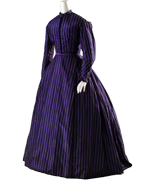Technology expands the aesthetic vocabulary of fashion even as it streamlines the process of clothing production. Today, the term "techno-fashion" is used to refer to a predominantly twenty-first-century phenomenon, but technological advancements were shaping fashion design and fabrication as early as the mid-eighteenth century. Fashion and Technology focuses on innovations over the past 250 years that have influenced the production, materials, aesthetics, and function of fashion.
"Technology has always been the essence of fashion . . . The fast-paced progress of technology complements fashion’s ever-evolving aesthetic, and each gives the other a wider frame of reference and more scope to explore new horizons." ~ Bradley Quinn
 The Industrial Revolution of the eighteenth and nineteenth centuries brought about innovations in textile manufacturing that included the introduction of the Spinning Jenny, the Jacquard loom, and the sewing machine. The Jacquard alone was ten times faster than hand weaving, and the Spinning Jenny mechanized the manufacture of cotton thread, thus enabling the mass production of cotton textiles. In addition, the introduction of synthetic dyes in the mid-nineteenth century allowed dressmakers to achieve the brilliant, fade-resistant colors that have become synonymous with fashions of that period.
The Industrial Revolution of the eighteenth and nineteenth centuries brought about innovations in textile manufacturing that included the introduction of the Spinning Jenny, the Jacquard loom, and the sewing machine. The Jacquard alone was ten times faster than hand weaving, and the Spinning Jenny mechanized the manufacture of cotton thread, thus enabling the mass production of cotton textiles. In addition, the introduction of synthetic dyes in the mid-nineteenth century allowed dressmakers to achieve the brilliant, fade-resistant colors that have become synonymous with fashions of that period.
Following World War II, breakthrough developments as disparate as the washing machine and space travel had a profound impact on fashion. American designer Claire McCardell created washing machine–safe sportswear engineered to meet the needs of the suburban housewife;
across the Atlantic, Parisian couturiers Pierre Cardin and André Courrèges cited the space race
as a primary inspiration for their new, youthful fashions. With the first man orbiting Earth in 1961,
it seemed apparent to these designers that an era of recreational space travel was just around
the corner.
